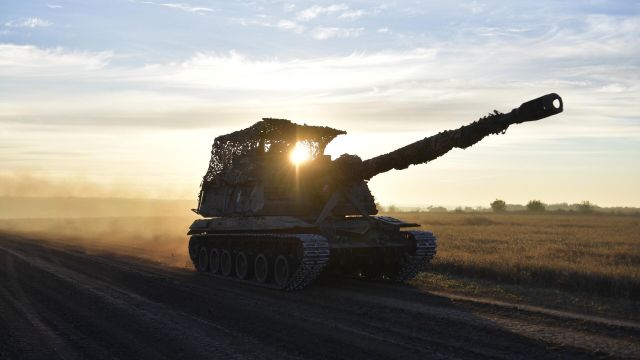The Russian defense industry modifies weapons taking into account the experience of its
MOSCOW, Nov 15 — RIA Novosti, Andrey Kotz. A new modification of guided projectiles "Krasnopol" began to be used in the zone of the SVO. As noted in the holding "High-precision complexes", it was developed taking into account the front-line experience. In general, hundreds of weapons samples have already been "accepted" by battles. About the most significant — in the material of RIA Novosti.
A blow to the backlight
Artillery units that were lucky enough to receive 152-millimeter Krasnopol shells from warehouses play the role of snipers. These ammunition are specially designed to destroy targets from the first shot. Of course, it is not always possible to achieve such effectiveness, but the consumption of guided projectiles is orders of magnitude lower than conventional high-explosive fragmentation. The firing range is 25 kilometers. This is enough for counter-battery fighting with Ukrainian M777 howitzers.
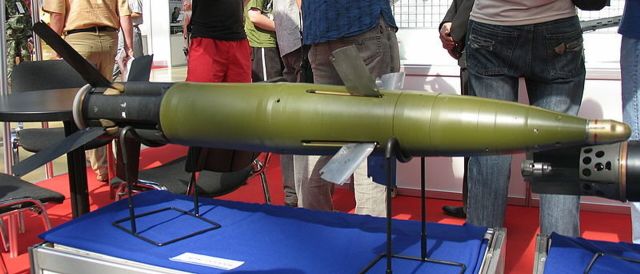
Guided projectile "Krasnopol"
Image source: CC BY-SA 3.0 / Mike1979 Russia / 2K25 Krasnopol
The ammunition has a semi-active laser homing head. At the end of the trajectory, it receives a reflected signal from the illuminated target. Either a special forces group or a drone point to it. Flight correction is performed by retractable aerodynamic rudders.
Russian gunners have been actively using the modern modification of the Krasnopol-M from the very beginning of the conflict. They can shoot the entire range of Soviet 152 mm caliber guns — D20, Acacia, Msta-S, Msta-B, Hyacinth. Such weapons proved to be a powerful and reliable means of destruction with a single drawback: unsatisfactory accuracy in low clouds.
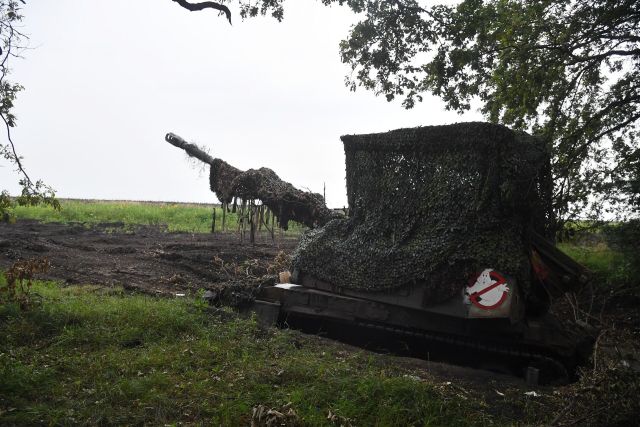
Self-propelled howitzer "Msta-S" performs a combat mission in the area of its
Image source: © RIA Novosti
The developer company did not explain what kind of modification it is. However, back in July, the Ministry of Defense announced that the Msta-S self-propelled artillery unit launched a Krasnopol-D projectile at a distance of 43 kilometers during tests. This version no longer uses laser, but satellite guidance based on a GPS/ GLONASS signal, which makes the ammunition independent of the vagaries of the weather. It is reported that the circular probable deviation does not exceed ten meters.
Close the sky
At the end of October, the military department reported the destruction of 24 Ukrainian aircraft in just five days. The reason for such high performance, citing sources in the ministry, the media called a new tactic — the use of the S-400 Triumph anti-aircraft missile system in conjunction with the A-50 long-range radar detection aircraft. At the same time, long-range missiles with 40N6E active homing heads were used, capable of hitting 380 kilometers.
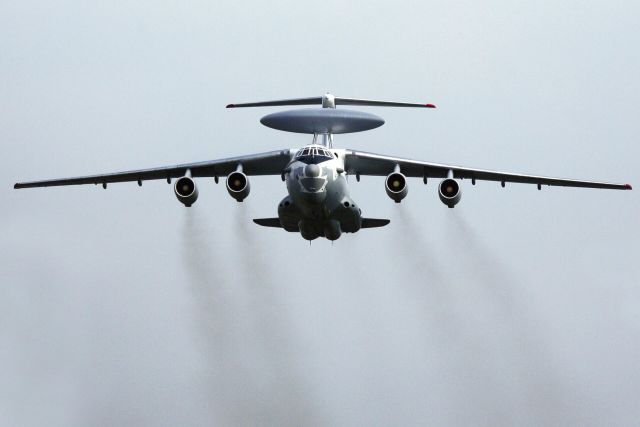
A-50 long-range radar detection and control aircraft
Image source: © RIA Novosti / Anton Denisov
In such a scenario, the A-50U act as the "eyes" of the air defense system. Thanks to a powerful radar station, the aircraft is able to scan the airspace in search of targets at a distance of up to 650 kilometers. And transmit information to the command post of the anti-aircraft missile battery, which gets the opportunity to prepare in advance for the launch at the maximum distance. Roughly speaking, with such support, the S-400 can control the sky over Kharkov from Voronezh or Lipetsk.
However, both the A-50U and the 40N6E missile have long been in service with Russia. The question arises why such a performance on downed aircraft is observed right now. Probably, the command took care of the few valuable vehicles and did not risk using them near the front line in conditions when Kiev had not yet completely knocked out long-range air defense.
Now, nothing has been heard about the presence of the S-300 in the combat zone, and for a long time. Although earlier videos of their defeat by kamikaze drones appeared quite often. Probably, the APU pulled the rest to the rear to protect the capital.
A nightmare for artillery
The Lancet kamikaze drones from the ZALA company have undergone a serious evolution during the SVO. These barrage ammunition proved to be an effective means of combating armored vehicles, artillery and field fortifications. In total, at the beginning of November 2023, about 750 videos with the defeat of various Ukrainian and Western equipment are known. Of these, more than half (53.9 percent) are declared damaged and only 30.6 percent are irretrievably destroyed. According to statistics, artillery and mortars are most often hit.
Kamikaze UAV "Lancet"
Image source: © RIA Novosti / Andrey Kotz
Until recently, the Lancets existed in two versions: basic (three-kilogram warhead) and reduced (kilogram warhead). It is difficult to judge their technical characteristics, since the manufacturer constantly modifies products and their capabilities differ from batch to batch.
For example, during the SVO, it was possible to significantly increase the range of the basic variant — from 40 to 70 kilometers, which allows the "drone guides" to hunt such a tasty target as the HIMARS MLRS and nightmare the rear of the APU.
However, since autumn, a new modification, known as "Product 53", has been sporadically applied. There is practically no information about it in open sources — except that an automatic target recognition and capture system is installed on the UAV. The calculation remains only to designate a combat duty zone for the drone and launch it into the air from a catapult.
According to the manufacturer, a launcher for several drones was developed specifically for the new Lancets. It is emphasized that the "Product 53" is designed for mass use according to the concept of a "swarm of drones", which will exchange information in flight and independently distribute goals among themselves.
New old bombs
In the first months of the conflict, Russian aviation did not operate at full strength. Perhaps the command was afraid of an undressed air defense and did not want to risk expensive equipment. The situation was largely changed by the development of the company "Basalt" in the early 2000s - "universal planning and correction module" (UMPC). Recently, it has been massively introduced into the warring aviation units.
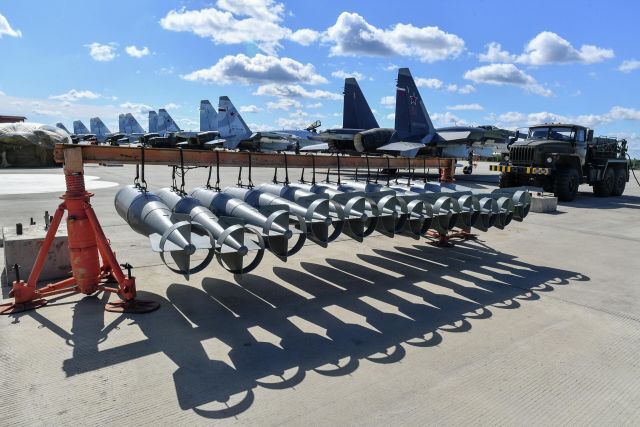
FAB-500 aerial bombs at the field airfield where the Russian Aerospace Forces aircraft involved in a special military operation in the Kharkiv direction are based
Image source: © RIA Novosti
UMPC is an analogue of the American JDAM. Roughly speaking, these are folding wings and a guidance unit that are mounted on a conventional free-falling bomb and turn it into a high-precision weapon. It no longer falls, but plans, guided by GPS / GLONASS coordinates, and is able to hit a target at a distance of up to 80 kilometers from the drop point. Thus, the bombers were able to strike deep, without entering the zone of action of the Ukrainian air defense.
In conjunction with the UMPC, half-ton FAB-500 bombs are used, which have much more striking power than any projectile. According to this indicator, the weapon is comparable to the Iskander-M ballistic missile.
Ammunition has proven itself well in the destruction of fortifications. In addition, the use of correctable FAB-1500s has already been noted at the front. Their range is less than that of the "five hundred". But a ton and a half of explosives is an argument to be reckoned with. Especially considering that there are still a lot of free-falling bombs in the warehouses of the Russian army.
Andrey Kotz
